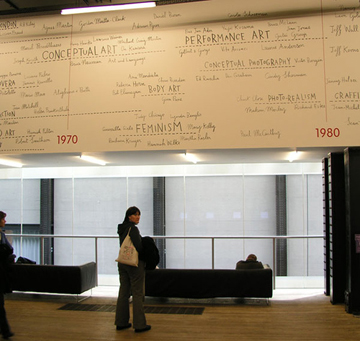
At a recent trip to Tate Modern I spent some time looking closely at something I’d regularly passed by without really thinking about it. On two floors of the museum, by the entrances to the four galleries of permanent holdings, there is a timeline of twentieth-century art, written in the cursive script reminiscent of Tate’s chosen font (a round-headed sans serif of implicit, somewhat patronizing accessibility). The timeline, designed by Sara Fanelli as part of their UBS-sponsored 2006 rehang, underscores Tate Modern’s (highly successful) public profile as a fun day out with a bit of weird art thrown in. The timeline intersperses the names of art movements in wonky caps with the names of artists associated with them, clustered around like moths. The thinking is that the public will respond favorably to the cutesily handmade (its ubiquity in branding is remarkable), which can make the apparently unpalatable (the history of conceptual photography, or a faceless global conglomerate) seem sweet and likeable. This notion is carried through in Tate’s identity in wall texts and advertising.
What’s interesting, though, is the notion of creating a Barr-style timeline for the history of postmodern/contemporary art, something that contemporary art historians might balk at because of its Darwinian association of art as a series of improvements on the past. This remains entrenched in survey courses in western art history, which sees the high Renaissance as a lofty peak, with pre- and post-Renaissance art as the slopes leading up and down.
Teaching contemporary art as art history, then, presents certain problems: how do we go about constructing a history of the recent past? Are we in danger of being token in our selection of artists outside of the conventional framework of western art? Clearly the Tate Modern-style approach is too overly redolent of established histories of art (it may be appropriate for more obviously developmental periods, though, such as Archaic, Classical and Hellenistic sculpture). But as educators, what method can we use to make sense of art of, say, the last 50 years for the benefit of students? In general, I tend to lean toward the unapologetically idiosyncratic. This charming “timeline” by James Elkins from Stories of Art is a good example of a defiantly non-linear “history of art” that might make more sense for art of the recent past.
I’d love to hear how other educators might consider approaching this idea. Who’s in and who’s out – and why?



